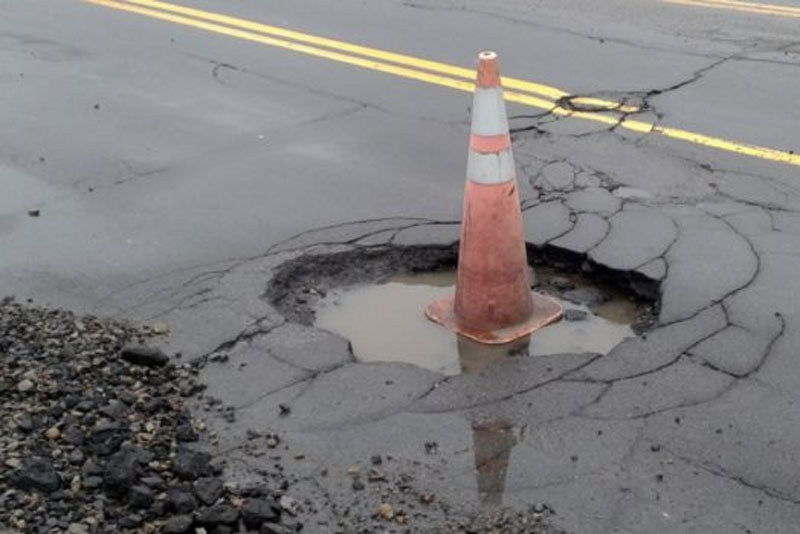
As residents and tourists hit South Carolina roads this July 4th holiday weekend, they will contend with plenty of potholes and higher state gasoline taxes.
Meanwhile, newly released records show that the S.C. Department of Transportation – the agency tasked with fixing pothole-riddled, state-maintained roads, continues to sit on massive reserves – more than $563 million as of May 31 – generated by the gas-tax-hike law that took effect three years ago.
The 2017 law hiked the state gas tax by 12 cents over six years – a 75% jump from the base 16 cents – and increased other vehicle taxes and fees. The gas tax goes up another 2 cents effective today.
The Nerve’s latest review of DOT records found that for unexplained reasons, five identified “pavements” projects in Aiken, Berkeley, Charleston and York counties were projected to cost a total of $8.2 million as of April 30, but by May 31, the estimated total for those projects had dropped to $0.
Two of the projects in Berkeley County, which had a collective estimated cost of nearly $3.5 million, were listed as “Null” in the records. The three other projects in Aiken, Charleston and York counties had $0 amounts listed in the May records, though construction completion rates were recorded as ranging from 16% to 86%.
The discrepancies raise questions about the reliability of DOT’s public records and how much money is actually being spent to fix bad roads.
In passing the gas-tax-hike law, S.C. lawmakers promised that the money would be used to fix the state’s crumbling roads and bridges. DOT has said 80% of the state’s approximately 42,000 miles of roads needs resurfacing or rebuilding, and identified 465 out of 750 “structurally deficient” bridges to be replaced.
But of the $1.35 billion in “project commitments” listed by the agency as of May 31, $258.5 million, or 19% of the total, was designated for interstate widenings. DOT began to more clearly acknowledge those plans publicly following a January 2019 Nerve story.
Sen. Hugh Leatherman, R-Florence, last year created a special Senate panel to study accelerating interstate expansion. Leatherman is the longtime chairman of the budget-writing Senate Finance Committee and also sits on the State Transportation Infrastructure Bank (STIB) board, which over the years funneled several billion dollars to major construction projects in select counties.
The South Carolina Policy Council, the parent organization of The Nerve, has contended the gas-tax-hike law was written in a way to allow DOT to divert revenues to the STIB to pay off bond debts.
As of May 31, the state had collected a total of $1.23 billion in revenues under the law, of which $563.3 million, or nearly 46%, was left over in reserves, according to DOT and state comptroller general records. Total collections as of that date represented nearly 91% of the overall “project commitments” identified by DOT.
DOT recorded making a total of $559.7 million in vendor payments as of that date, while a collective $110 million was split between transfers to the County Transportation Committee (CTC) program for local roads and to the state Department of Revenue to cover income tax credits allowed by the law.
The Nerve’s latest review of DOT records found that the total dollar amount of completed “pavements” projects that were identified in the state’s 46 counties was $415.2 million, or 45.4% of the estimated collective $913.8 million cost of all such projects in those counties as of May 31.
Following is a list of 15 counties in which the total dollar amount of completed “pavements” projects was less than 40% of the collective projected cost of all such projects in those counties as of May 31, according to DOT records:
- Hampton: $3.6 million (39.6%);
- Kershaw: $5.2 million (39.5%);
- Spartanburg: $11.8 million (39.4%);
- McCormick: $2.2 million (38%);
- Allendale: $2.7 million (35.9%);
- Oconee: $7.7 million (33.5%);
- Darlington: $4.8 million (33%);
- Lee: $2.3 million (32.5%);
- Anderson: $14.3 million (32.4%);
- Horry: $20.4 million (29.8%);
- Newberry: $4.5 million (26.7%);
- Pickens: $4.9 million (21%);
- Calhoun: $944,875 (12.3%);
- Orangeburg: $3.1 million (11.5%);
- Georgetown: $2.7 million (10.4%)
Brundrett is the news editor of The Nerve (www.thenerve.org). Contact him at 803-254-4411 or

















